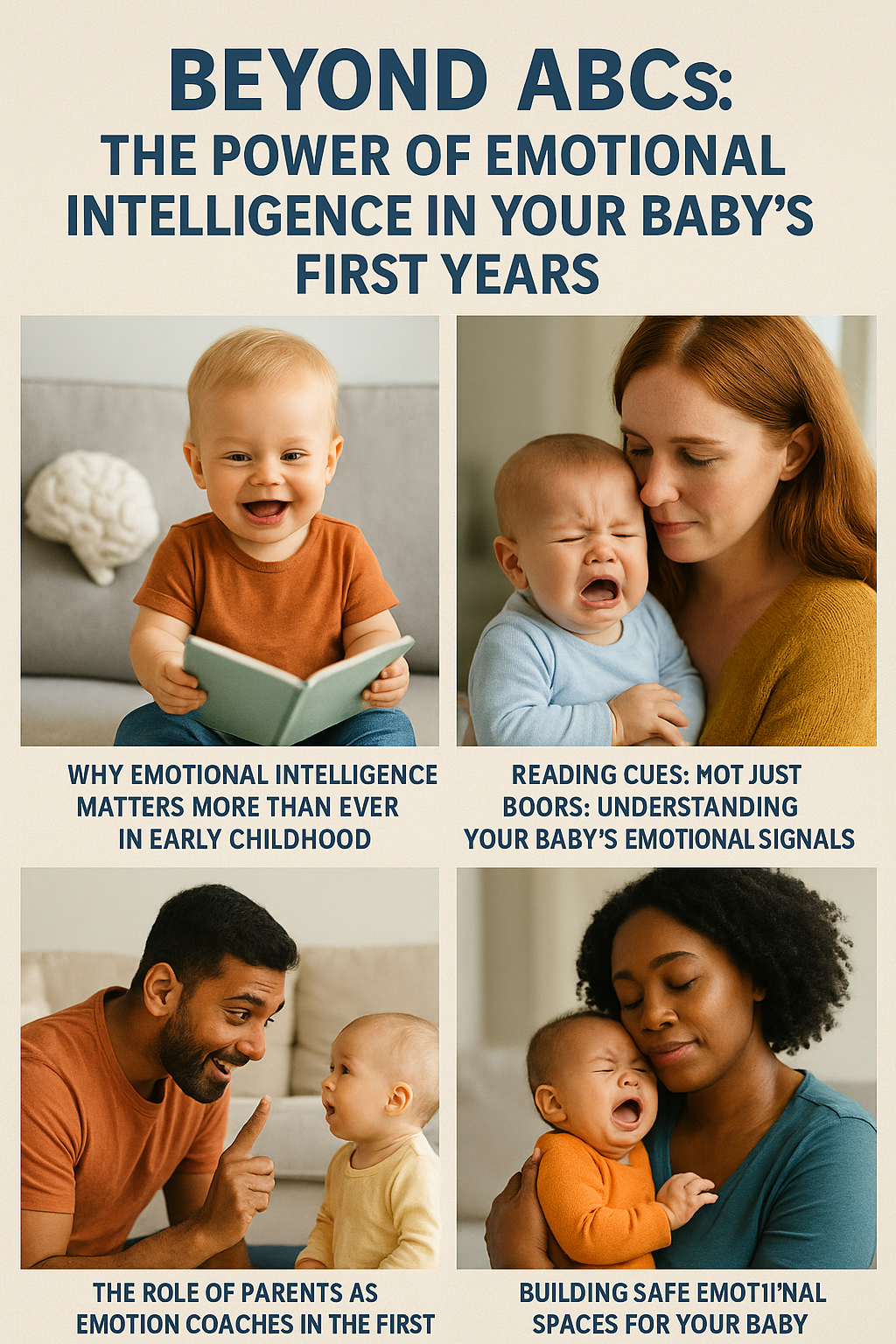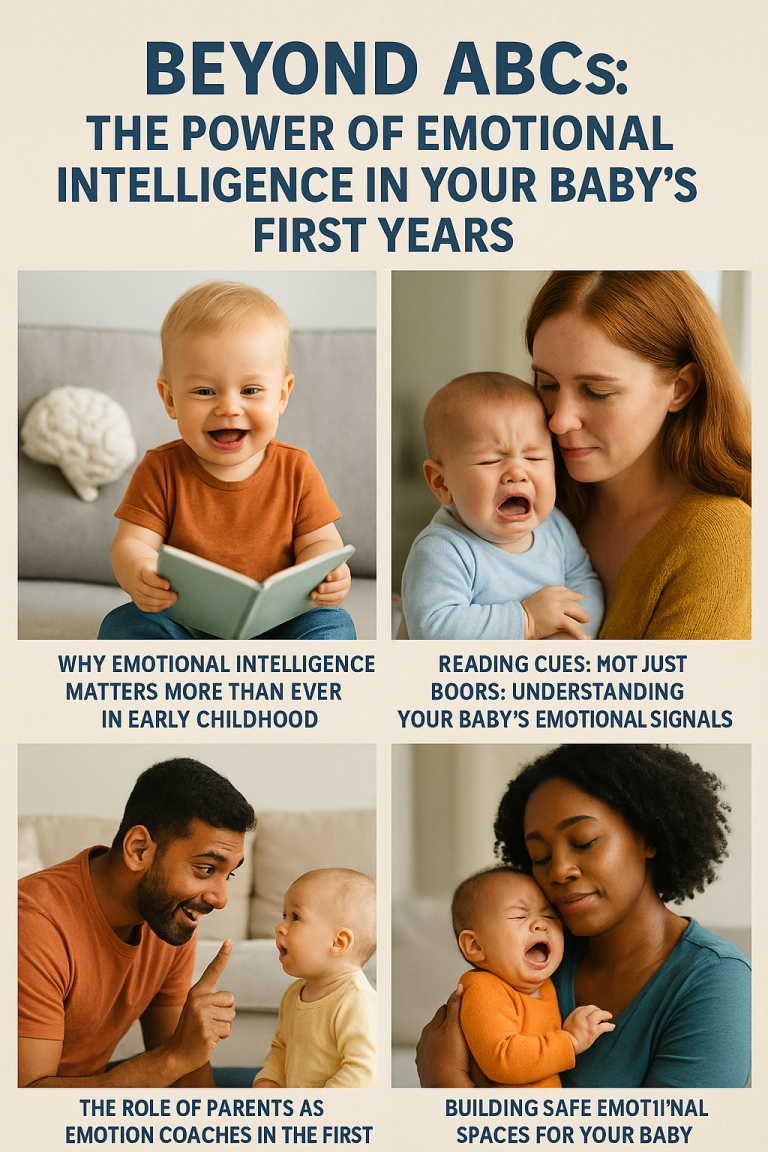
Introduction: The New Alphabet of Early Childhood
In a world obsessed with milestones—first words, first steps, first books—it’s easy to forget what lies beneath those “firsts”: emotion. Before babies can talk, they feel. Before they can walk, they connect. And before they can read, they read us—our faces, our tones, our presence.
The traditional checklist of early education has long focused on letters and numbers. But today, a new paradigm is taking root, one that prioritizes the internal alphabet of emotional fluency. In this approach, joy, frustration, curiosity, and comfort become as important as the ABCs.
Emotional intelligence—or EQ—is not just a corporate buzzword or teen self-help goal. It begins in infancy. And when nurtured intentionally, it shapes a child’s sense of self, their ability to relate, to regulate, to love, and to thrive.
1. Why Emotional Intelligence Matters More Than Ever in Early Childhood
In the digital age, emotional intelligence is emerging as a critical predictor of lifelong success—outweighing even IQ in some studies. But its importance doesn’t begin in the boardroom. It starts in the bassinet.
Why emotional intelligence matters more than ever in early childhood is rooted in how the brain develops. The first three years of life are a time of unparalleled neuroplasticity. Neural connections form at staggering rates, particularly in areas of the brain that process emotion, social connection, and self-regulation.
A child who feels seen and soothed learns that emotions are manageable, not monstrous. In turn, this lays the groundwork for resilience, empathy, and self-awareness—qualities desperately needed in an overstimulated, fast-paced world.
Moreover, emotional intelligence is the invisible thread that ties together healthy relationships, mental health, communication skills, and even academic performance. Children with high EQ tend to experience fewer behavioral issues, stronger friendships, and greater adaptability in school and beyond.
2. Reading Cues, Not Just Books: Understanding Your Baby’s Emotional Signals
Before language, there is the gaze. The coo. The wriggle. The cry.
Babies are born communicators. Their emotional signals—though wordless—are potent forms of expression. Learning to decode these is just as crucial as reading bedtime stories.
Reading cues, not just books: understanding your baby’s emotional signals means tuning into their nonverbal language. Does that high-pitched squeal mean excitement or overstimulation? Is the furrowed brow signaling a need for a nap or for a break from the crowd?
Emotional literacy starts with parental sensitivity. When caregivers respond consistently and empathetically to these cues, babies begin to internalize the idea that their emotions are valid and their needs matter.
It’s not about perfection. It’s about presence. Responding to a baby’s emotional bid—even imperfectly—builds trust. That trust is the soil in which emotional intelligence takes root.
3. The Role of Parents as Emotion Coaches in the First 1000 Days
There’s a reason the first 1000 days—conception to age two—are called the “golden window” of development. The brain is sculpted by experience. And parents are the primary artists.
The role of parents as emotion coaches in the first 1000 days is not to fix every feeling, but to walk beside it. Coaching doesn’t mean controlling. It means helping children name what they feel, tolerate what they feel, and ultimately learn to express those feelings in healthy ways.
This begins with co-regulation—calming the baby through touch, voice, and proximity. Over time, it evolves into guidance: “I see you’re frustrated. That block tower fell, and that’s hard.”
These micro-moments become emotional blueprints. Children who are emotion-coached tend to develop better problem-solving skills, richer vocabularies for feelings, and stronger emotional resilience.
Even in infancy, tone matters. Validation matters. A whispered “I know, sweetheart, this is hard” can do more for emotional growth than a hundred flashcards.
4. From Tantrums to Trust: Building Safe Emotional Spaces for Your Baby
A tantrum is not just noise. It’s data. It’s the body’s loudest way of saying, I’m overwhelmed and I don’t have the words.
From tantrums to trust: building safe emotional spaces for your baby begins with changing the adult perspective. Instead of seeing tantrums as defiance, we can begin to view them as disorganized emotional storms—a baby’s nervous system asking for help regulating.
Babies don’t throw tantrums to manipulate. They do it because their emotional circuitry is still under construction. The amygdala—the brain’s emotional alarm system—is fully online, but the prefrontal cortex—the calm, rational part—won’t mature for years. That’s why they borrow our calm.
Creating a safe space means responding with groundedness, not guilt or anger. It’s knowing that the meltdown in the car seat is not a failure of parenting but a normal neurological stage.
This approach is not permissive; it’s proactive. It sets boundaries with empathy. It says, “You may not hit, but I’m here. Let’s take a breath together.”
Over time, these repeated experiences wire the baby’s brain for trust. They learn that feelings—even big, messy ones—can be felt and survived with connection, not punishment. That trust becomes the emotional backbone of their future relationships.
5. Attachment, Attunement, and the Foundations of Empathy
Empathy isn’t taught with words. It’s absorbed through experience.
Attachment, attunement, and the foundations of empathy are deeply intertwined. Secure attachment—the emotional bond between caregiver and child—is built through consistent, sensitive interactions. But attachment alone isn’t enough. Attunement adds nuance.
Attunement is the parent’s ability to “tune in” to the baby’s inner world, not just their outer behavior. It’s the subtle art of recognizing what a sigh means, or when a baby pulls away, or when they seek comfort through eye contact. It’s being emotionally with the child, not just physically near.
When a caregiver mirrors back a baby’s emotions (“You’re smiling—this must feel fun!” or “You’re frowning—do you feel confused?”), the child begins to internalize the capacity for empathy. They learn, through felt experience, what it means to be understood.
These early moments of emotional mirroring create neural pathways that make empathy possible later in life. A child who has been empathized with becomes more capable of empathizing with others.
In a culture obsessed with achievement, this quiet foundation may be the most vital one of all.
6. How to Cultivate Self-Regulation Before Speech Develops
Speech takes time, but self-regulation starts sooner.
How to cultivate self-regulation before speech develops lies in the dance between emotional containment and freedom. Babies need help naming their inner weather system long before they have words to describe the storm.
Through routines, gentle physical touch, calm facial expressions, and predictable rhythms, parents provide what scientists call external regulation. In time, babies internalize this process and begin to self-soothe.
Simple rituals—a lullaby before nap, a cuddle during distress, a pause before transitions—act as anchors. They help the child learn how to shift from chaos to calm.
Even a baby mouthing their hands or rocking slightly is practicing early regulation. These small self-initiated actions are building blocks for emotional independence.
It’s crucial not to rush this process. Regulation is not repression. It’s not about teaching babies to not feel. It’s about helping them carry their feelings without collapse or panic.
Before babies say “I’m sad,” they learn it’s okay to be sad—and to be held in it.
7. Simple Everyday Habits That Boost Emotional Growth in Babies
The good news? You don’t need a PhD in psychology to raise an emotionally intelligent child. You need presence. Intention. And a willingness to slow down.
Simple everyday habits that boost emotional growth in babies include eye contact, naming emotions aloud, shared routines, and playful interaction. These are the subtle superpowers of emotional parenting.
Talk to your baby as if they understand—because they do, more than you think. “You’re frustrated because the spoon fell again. That’s okay.” Over time, these narrated feelings become emotional vocabulary.
Use emotional reflection during play. “That bear looks sleepy. Let’s tuck him in.” This helps babies link feelings with behaviors in a safe, imaginative space.
Make space for “quiet delight”—those unhurried moments where nothing is taught, but everything is absorbed. A walk in the park. A face-to-face giggle. A shared stare at the ceiling fan. These moments are not filler. They are formative.
Empathy is not downloaded like an app. It is hand-delivered through these micro-interactions.
Conclusion: Growing the Heart Before the Mind
As parents, we are often asked: “When will they walk? When will they talk? When will they read?”
But perhaps the more meaningful questions are:
When will they feel safe enough to explore?
When will they trust enough to connect?
When will they know it’s okay to be sad, mad, or scared—and still be loved?
Emotional intelligence is not an extra. It is the infrastructure of everything that follows. It is the bridge between stimulus and response, between instinct and intention, between surviving and truly thriving.
So let’s raise babies who not only know their ABCs but who can name what they feel, ask for what they need, and offer compassion in a world that so often forgets its heart.
Because beyond letters and numbers, it’s our feelings that make us human—and it starts right here, in the first years, with you.




